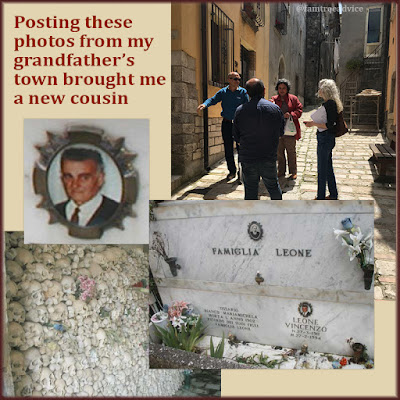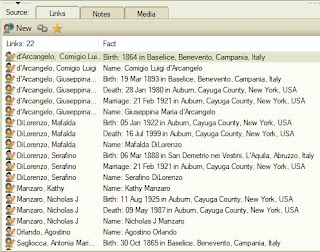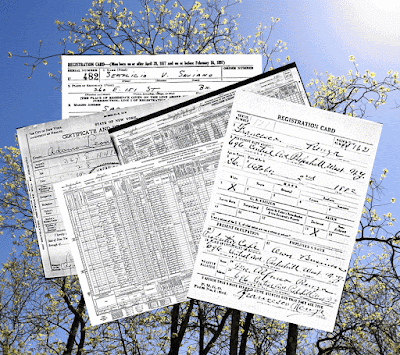I love when someone finds their family in my online tree and contacts me. Last week I heard from a new-found 4th cousin.
Often our connection is distant—cobbled together through the relatives of in-laws. I had this type of connection last week, too. A woman found her grandmother in my tree and wanted to know what else I could tell her.
I told her everything came from the 1920 census and a few New York City death certificates. But I had nothing else to offer.
In fact, as I wrote in my reply, she shouldn't be in my family tree at all. I explained that her grandmother's sister married a man named Celentano. That man's uncle married my grandmother's 1st cousin, Consiglia Sarracino.
I knew from the names Celentano and Sarracino that this was some of my earliest family tree research. When I started, I followed every possible thread for my American cousins.
I used censuses to stretch out the Celentano family as far as I could. And then I built out the families of the people who married into the family. That's how her grandmother wound up in my tree.
Enforcing the In-Law Rule
It wasn't until much later in my genealogy life that I created an in-law rule:
I will not add anything to an in-law's profile beyond their facts and their parents' facts UNLESS my cousin asks me to research that family.*
*This rule does not apply to my Italian research where entire towns are inter-related, and I want everyone.
 |
| Establish a rule to keep your family tree on the path you want. |
How many other far-flung in-law branches are still in my family tree? How can I find them in my enormous file?
I explored Family Tree Analyzer software for a while, but it wasn't a shortcut. Maybe there is no shortcut.
Stragglers in my tree would come from my parents' and grandparents' generations. Those are the people I would have found in my early census searches.
Most of my close cousins are from my maternal grandmother's family. In my earliest days, I would have spent time on the families of Grandma's aunts and uncles, the Saviano family.
This is a manageable group to work with. Grandma had only 3 Saviano aunts or uncles who lived long enough to marry and have children.
Uncle Semplicio
As a little girl, my mom was afraid of her great uncle Semplicio. He was an older man with one eye. He literally lived in a closet next to her apartment for a while.
Long ago I met someone online with a connection to Semplicio's wife Giovina. With his encouragement, I built an enormous tree for Zia Giovina. Once I decided to follow my in-law rule, I cut out every relative but Zia Giovina's parents.
Looking in Family Tree Maker, I see families for 3 of Semplicio and Giovina's children. I can view each family to see if I need to delete anyone. Nope. Everyone was following the in-law rule.
Aunt Filomena
My grandmother's aunt is an example of going out of my way to document an in-law. But I want it this way. One of her grandsons is very interested in our family history, and he helped me with it.
Plus, Filomena's husband came from a town very close to Filomena's Italian hometown. There may be a family tie somewhere in their past!
Uncle Raffaele
Uncle Raffaele died long before I was born, but his wife Lucia was sometimes at family gatherings. My brother and I knew her and Aunt Filomena as "Zee Loo Gee" (Zia Lucia) and "Zee Vulla Men" (Zia Filomena). We never saw Zee Vulla Men without Zee Loo Gee.
I have extended families for Raffaele and Lucia's children in my family tree. Clicking through to view them all, I found only one in-law family I should delete. I do want to preserve the research, but not in my main tree. I'll follow my own advice and export this group of people to a new tree before deleting them from mine. (See "How to Export and Delete Branches from Your Family Tree.")
Exporting the 46-person branch was easy, but it didn't seem to capture the media files. I'll do that myself. My document tracker file will help me see which media files belong to this batch of people.
Deleting the branch was tricky. There wasn't one ancestor whose descendants capture the whole group. Instead, I worked my way through the families, noting all their media files. Then I viewed a family tree chart for each group and deleted them from my family tree.
I made sure all the right media files were no longer in my main tree, and I exported a new GEDCOM from Family Tree Maker. A GEDCOM is a text file that follows a standard format that any family tree software can understand. I opened the GEDCOM with Family Tree Analyzer to see if I missed anyone. Would FTA find unrelated people from this branch still in my family tree?
 |
| If your family tree is big, Family Tree Analyzer can narrow it down to certain types of names for you. |
Here's how to check:
- Launch Family Tree Analyzer and open your latest GEDCOM.
- Go to the Main Lists tab to see everyone in your tree on the Individuals tab.
- To exclude close family and true cousins from this search:
- Scroll to the right to find the Relation to Root column.
- Click the arrow button at the top of the column to open a small window.
- Unclick Select All, then click to select only the blank field at the top of the list.
- Click the Filter button to close the small window.
- Scroll all the way left to find the Surname column.
- Click the arrow button at the top of the column and choose Sort A to Z.
- Browse the shorter list for the last names you don't want to find.
Success! I didn't find anyone who wasn't supposed to be there. Now I can backup and save my Family Tree Maker file.
But I'm not really done, of course. I have some cousins through my paternal grandmother, and her mother had a bunch of brothers. I can run through this same process with that branch and a few others.
Should You Do This, Too?
The main reasons for going through this export/delete process are:
- to stop misleading people into thinking you're their blood relative
- to stop spending time on branches that aren't the focus of your family tree
- to conserve computer resources.
Plus, I don't like it when I see a name in my tree index and think, "Who on earth is that?"









